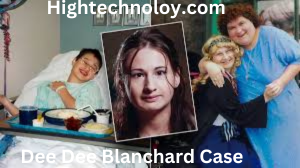Alright, let’s dive into something that’s equal parts fascinating and disturbing—the Dee Dee Blanchard case. If you’re like me, the name might ring a bell because of the Hulu series The Act, or maybe you’ve been down the true crime rabbit hole. Either way, Dee Dee Blanchard and her daughter, Gypsy Rose, are at the heart of one of the wildest stories out there.
But let’s be honest: it’s not just the story that grabs us. It’s the photos. There’s something about seeing the real-life images tied to such a bizarre case that makes it all feel even more unreal. If you’ve ever found yourself scrolling through images connected to the case, thinking, “How is this real life?”—yeah, same.
Why Dee Dee Blanchard’s Photos Hit Differently
First, let’s talk about why these particular photos draw so much attention. I mean, true crime photos are always kind of weirdly compelling, right? It’s like you know you shouldn’t be looking, but you can’t help it. With Dee Dee Blanchard, though, it feels even more intense.
For one, there’s the fact that on the surface, she looked like a sweet, doting mother. In the photos, she’s often seen with Gypsy Rose, her daughter, who was made to believe (and made the world believe) she was chronically ill. Gypsy’s in a wheelchair, looking fragile, and there’s Dee Dee, holding her close, smiling like the most loving mom ever. But knowing what we know now—that Dee Dee was manipulating Gypsy, faking her illnesses for sympathy and financial gain—it makes those photos feel so… off.Dee Dee Blanchard case.
It’s like seeing two completely different realities at once. In one reality, Dee Dee’s just your average loving parent. In the other? She’s orchestrating one of the most twisted cases of Munchausen by proxy that we’ve ever heard about.
Read More:Retro Bowl 3KH0: A Nostalgic Journey into Digital Football
The Emotional Rollercoaster Behind the Photos
If you’ve ever taken a deep dive into the Dee Dee Blanchard case (and trust me, I’ve been there—hours of Googling later), you know the emotional rollercoaster it can take you on. One minute you’re feeling sorry for Gypsy, trapped in this web of lies her mother spun. The next, you’re wondering how on earth Dee Dee managed to convince so many people that her daughter was sick.
Now, when you look at the released photos, you’re not just seeing a mom and daughter. You’re seeing manipulation. You’re seeing control. And, if we’re being honest, you’re probably feeling a little weirded out that these seemingly normal images can carry so much darkness.
The “Perfect” Image of Dee Dee
What’s crazy is how Dee Dee Blanchard managed to craft such a perfect image for the public. I mean, in the photos, she’s usually smiling, her hair curled or pulled back neatly, sometimes wearing glasses that make her look almost teacher-like—kind of nurturing, you know? She looks like the definition of a supportive mom.
And that’s the kicker. She knew exactly what she was doing. She wasn’t just conning people about her daughter’s illnesses; she was curating her own image as a selfless caregiver. And if you’re anything like me, you might’ve found yourself looking at those photos, staring at her face, and thinking, How did no one see through this? Like, she literally fooled doctors, friends, charities—everyone.Dee Dee Blanchard case.
But in hindsight, you start noticing little things. Maybe it’s the way she’s always holding Gypsy so close, almost like she’s physically controlling her. Or maybe it’s the look in Gypsy’s eyes, something hard to pin down, but definitely not joy. The more you know about the case, the more you read into these photos, and it starts to get eerie.
The Aftermath: Gypsy and the Power of Images
And let’s not forget about the aftermath. Once the truth came out—that Gypsy had orchestrated her mother’s murder to escape years of abuse—those photos took on an entirely new meaning. Suddenly, they weren’t just pictures of a loving mom and her sick daughter. They were evidence of a crime, pieces of a puzzle that spanned years.
I’ll admit, it’s hard not to feel a twinge of guilt when looking at these pictures now. It’s like you’re invading Gypsy’s life, staring at moments that she probably doesn’t want to relive. But at the same time, they offer a window into what she endured. You can’t look away because it feels like a piece of the story you need to understand, even though it’s so heavy.Dee Dee Blanchard case.
Why We Keep Looking: The Morbid Curiosity Factor
Now, let’s get real for a second: why are we all so obsessed with these photos? I think it’s partly because they’re such a stark contrast to what we know happened behind the scenes. You’ve got these relatively mundane pictures—birthday parties, family outings, hospital visits—and you realize how much of it was a façade. It’s like trying to reconcile two versions of reality, and our brains can’t quite process it, so we keep looking.
There’s also the morbid curiosity factor. As humans, we have this weird attraction to the darker sides of life, especially when it comes wrapped in something as seemingly normal as a family photo album. It’s unsettling, but it’s fascinating. It’s the kind of thing where you know you shouldn’t look, but you do anyway, because you want to understand how something so horrifying could unfold in plain sight.
My Personal Take: It’s Still Shocking
I remember the first time I really dug into the Dee Dee Blanchard case, scrolling through article after article, looking at those photos, trying to wrap my head around it all. At first, it didn’t compute. How could someone look so normal, yet be doing something so horrible? I found myself feeling a mix of sadness, frustration, and disbelief. And honestly, even now, after knowing the full story, those feelings haven’t gone away. Every time I see one of those photos pop up online, it’s like I’m right back at square one, trying to make sense of something that never fully will.
Final Thoughts: The Power of a Picture
In the end, the Dee Dee Blanchard photos are more than just snapshots. They’re pieces of a larger, much darker story. They’re the kind of images that stick with you, not just because of what’s in them, but because of what they represent—the manipulation, the lies, and the tragedy of it all.
I think that’s why people keep coming back to these photos. There’s something about seeing the reality behind the story that makes it all the more shocking, more real. It’s one thing to read about a case, but it’s another to see the faces of the people involved, frozen in time, unaware of how everything would eventually unravel.
So, if you find yourself going down the same rabbit hole I did, scrolling through those photos, trying to make sense of it all—don’t feel too bad. You’re not alone. It’s just part of being human. We want to understand, even when the story is as complicated and disturbing as this one.



